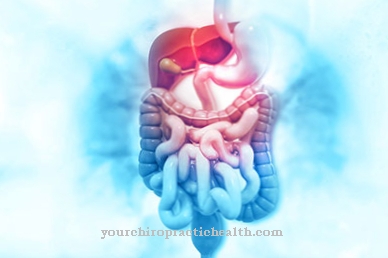Pemphigus foliaceus is an autoimmunological disease of the skin in which cells of the immune system break down proteins that bind the skin. This causes crevices to form on the skin, which then turn into blisters. Treatment is through systemic administration of glucocorticoids or other drugs that suppress the immune system.
What is pemphigus foliaceus?

© artitcom - stock.adobe.com
The human defense system recognizes pathogens and other substances of foreign origin as threats. After being identified as alien, the immune system starts attacks in order to eliminate any dangers to the organism as quickly as possible. This process is disturbed in autoimmune diseases.
The immune system of those affected attacks the body's own tissue instead of foreign substances. Autoimmune diseases can be directed against any tissue. The doctor calls those of the skin autoimmune dermatoses. At Pemphigus foliaceus It is an autoimmune dermatosis that causes blistering of the upper epidermis layer and can affect other mammals as well as humans.
For human pemphigus foliaceus, medicine differentiates between four different forms: In addition to the sporadic Pemphigus foliaceus type Cazenave there is the one that is mainly found in South America Pemphigus braziliensis, the Pemphigus seborrhoicus and the Pemphigus erythematosus. As for most autoimmune diseases, the cause of the underlying immune disorder has not yet been conclusively clarified for pemphigus foliaceus.causes
Patients with pemphigus foliaceus develop autoantibodies that are directed against desmoglein 1. This is a protein within the desmosomes that is crucial for the cell cohesion of keratinocytes within the outermost skin layers. Through antigen-antibody reactions, the patient's body releases proteolytic enzymes that break down proteins.
Together with the proteins, these enzymes break down the connections between individual skin cells. Since the skin lacks cell cohesion, the keratinocytes round off. So-called acantholysis occurs. As a result, crevices form in the epidermis, which later form blisters. Desmoglein 1 occurs as a protein only to a small extent within the mucous membranes.
If it fails, its function in the mucous membranes is compensated by the desmoglein 3 of the upper mucous membrane layers. Because of this, the effects of pemphigus foliaceus are limited to the external skin. It has not yet been clarified which factors are primarily involved in the incorrect programming of the immune system. Primary causal viral diseases are discussed for autoimmune diseases, for example.
Symptoms, ailments & signs
Patients with pemphigus foliaceus have symptoms of slack and rapidly bursting blisters on the outer skin. The base of the blisters consists of weeping, crusty erosions that slowly expand and can cause generalized erythroderma. Erythroderma is a reddening that can affect the entire skin organ or larger parts of the skin.
The erosions of patients with pemphigus foliaceus have an unpleasant odor in many cases. The secretion contained in the blisters is broken down by bacteria, whose metabolic products are responsible for the bad smell. Some patients also complain of itching or burning skin. Since they rub the skin and scratch the blisters because of the itchiness, the blistering often spreads uncontrollably.
The spreading bubbles go back to the principle of the positive Nikolski phenomenon. In most cases, the blisters affect the head, face, and trunk. Blistering occurs only in the rarest of cases within the mucous membranes.
Diagnosis & course of disease
The diagnosis of pemphigus foliaceus is made by the dermatologist on the basis of serology and histopathology. The Nikolsky signs can give rise to initial suspicions. The patient's skin can be peeled off in the active stage, for example by applying slight tangential pressure. Autoantibodies can be observed in the serum and in the intercellular space.
In later stages of the disease there is also accelerated blood sedimentation. In addition, the blood count changes. Dysproteinemia occurs. Histopathologically, acantholytic blistering primarily affects the stratum granulosum. Evidence of acanthosis, papillomatosis or leukocyte infiltration can often be found within the dermis.
In terms of differential diagnosis, the disease must be differentiated from discoid lupus erythematosus and seborrheic dermatitis. In the case of a detailed diagnosis, the diagnosis is narrowed down to one of the four forms of disease. Like all other autoimmune diseases, pemphigus foliaceus is characterized by its individual course. This means that the prognosis for patients with the disease cannot easily be generalized.
Complications
Pemphigus foliaceus must be treated urgently, otherwise it can lead to more complications. The skin lesions caused by the autoimmune reaction of the body can spread over the whole body without treatment and cause so-called generalized erythroderma. In generalized erythroderma, the entire skin becomes inflamed and reddened.
Characteristic for the disease process are heat and protein loss, increased cell proliferation of skin cells and the expansion of blood vessels. Serious complications, which can even be life-threatening, occur with particularly pronounced skin reactions. A severe loss of fluids can cause life-threatening dehydration. Dangerous protein and heat losses occur due to the strengthened formation of skin cells and extensive skin flaking.
Furthermore, the dilation of the blood vessels often leads to severe cardiovascular diseases. The constant formation of bubbles and fluids also provides bacterial pathogens an ideal breeding ground. If left untreated, serious infections can develop, which can also be fatal. However, this risk can be intensified with the administration of immunosuppressants.
However, since pemphigus foliaceus can only be treated by suppressing the immune system, antibiotics are usually also given as a precaution during treatment to avoid serious infections. So far there is no curative treatment. The immune system must be constantly suppressed, so that preventive measures must be taken to avoid infectious diseases.
When should you go to the doctor?
Since pemphigus foliaceus does not heal itself and in most cases the symptoms worsen, treatment by a doctor makes sense. The symptoms can only be limited and alleviated through medical treatment. In the case of pemphigus foliaceus, the doctor should be consulted if blisters form on the skin, which do not go away easily and occur over a long period of time. Itching or severe reddening of the affected skin area can also indicate pemphigus foliaceus and should be examined by a doctor.
Since those affected often scratch themselves with this disease, the symptoms worsen. The blisters appear on different parts of the body and can make the patient's life much more difficult. Consult a doctor immediately in the event of these complaints. Usually pemphigus foliaceus can be diagnosed and treated by a general practitioner or dermatologist. The life expectancy of the person affected is not negatively affected.
Treatment & Therapy
The primary cause of pemphigus foliaceus has not yet been identified. For this reason, causal therapy is difficult. The disease is therefore regarded as an incurable disease with no causal therapy option.
Symptomatic and supportive treatment methods are available for the therapy of the patient. In essence, symptomatic therapy for pemphigus foliaceus is similar to treatment for pemphigus vulgaris. Glucocorticoids are administered systemically.
Initially, high doses are appropriate to stop the disease process. Once the Nikolsky's signs are negative and the skin defects begin to heal, a gradual reduction in dose is indicated. In addition to the glucocorticoids, patients may receive other immunosuppressants.
Continuous immunosuppressive therapy is just as important as taking care of the skin lesions. Antibiotics can be used to prevent complications. It is imperative to avoid the rapid discontinuation of individual drugs. In this context, recurrences of symptoms were often documented.
Outlook & forecast
The chronic autoimmune disease pemphigus foliaceus usually leads to death five years after the disease if left untreated. To improve the prognosis, dermatologists often prescribe holistic corticosteroid treatment, immunosuppressants, plasma exchange or immunoglobulin. The treatments that are supposed to lead to a reduction in the antibody titre are usually carried out in an inpatient setting and under supervision, in order to counteract any complications that may arise - including fatal ones - during therapy.
Since the 1950s, the use of corticosteroids over a period of one year has led to better long-term prospects for affected patients, so that up to 80% can continue to live symptom-free or even completely recovered in the long term. Those affected are often restricted in their daily activities during and after treatment, as they have to reckon with many hours of absence from work, weight loss and a lack of sleep. The exchange with other affected persons who have to go through the same thing can help them to cope with the change in their life.
Nevertheless, around 5% of cases still end fatally due to the consequences of treatment for systemic infections - less often after superinfection of the lesions - and lack of treatment. The sooner the disease is diagnosed and treatment is started, the better the chances of being able to live symptom-free for those affected.
prevention
So far, there are no promising preventive measures against pemphigus foliaceus available. The primary triggers of the autoimmune disease are not yet known. Only identifying and then avoiding the triggers could constitute a preventive measure.
Aftercare
In the case of pemphigus foliaceus, the options for direct follow-up care are severely limited in most cases. The affected person is dependent on the quick and above all on the early diagnosis and treatment of this disease so that no further complications arise and there are no other complaints.
It is necessary to take various medications. The doctor's instructions must always be followed. It is also important to ensure that the dosage is correct and that it is taken regularly in order to relieve the symptoms correctly and permanently.
When taking antibiotics, those affected should note that they should not be taken with alcohol in order not to reduce their effect. Drugs should not be discontinued quickly in pemphigus foliaceus. Regular check-ups and examinations by a doctor are also necessary to monitor the current state of the disease and to identify other damage early on.
You can do that yourself
Pemphigus foliaceus can be relieved with cortisone, which the doctor prescribes as tablets or infusions. When taking cortisone, patients should strictly adhere to the recommended dosage. The cortisone treatment protects against new inflammation, so that the skin erosions decrease. It is important not to unnecessarily irritate the affected areas of the skin. Side effects may occur when taking the preparations. This is exactly why the correct dosage plays such an important role.
Patients can also resort to ointments or lotions to heal the damaged skin. You should definitely listen to the doctor's recommendation. Careful, correct skin care prevents secondary inflammation. If there are other skin problems or autoimmune diseases, it is important that the doctor knows about them. In this way he can help to make the ideal adaptation of the medication.
To protect the damaged skin, of course, patients should not scratch themselves. Otherwise the problem will only get worse. Calming exercises and a good body awareness help to let the areas heal in peace. In this way, those affected can make life a little easier. Allergy sufferers should be particularly careful and avoid the allergy trigger as much as possible.













.jpg)

.jpg)
.jpg)











.jpg)